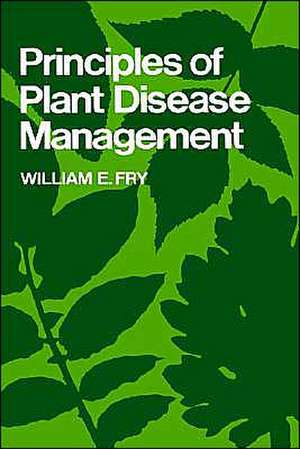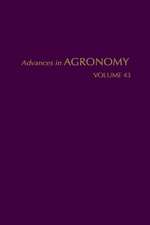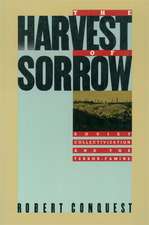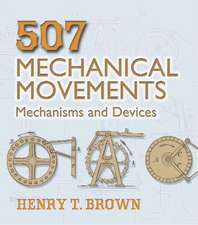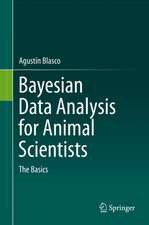Principles of Plant Disease Management
Autor William E. Fryen Limba Engleză Hardback – 6 ian 1983
- The technology of disease management is presented according to epidemiological principles
- Sections on diagnosis, epidemiology, environmental factors, disease forecasting, disease control (exclusion, physical, chemical and biological), plant resistance, cultural modifications to suppress epidemics, effects of chemicals and their major groups and uses, and examples of disease management in practice are included
- A bibliography and index are appended
Preț: 444.00 lei
Preț vechi: 576.63 lei
-23% Nou
Puncte Express: 666
Preț estimativ în valută:
84.97€ • 88.21$ • 70.85£
84.97€ • 88.21$ • 70.85£
Carte tipărită la comandă
Livrare economică 24 martie-07 aprilie
Preluare comenzi: 021 569.72.76
Specificații
ISBN-13: 9780122691805
ISBN-10: 0122691806
Pagini: 378
Ilustrații: 1
Dimensiuni: 152 x 229 x 30 mm
Greutate: 0.78 kg
Editura: ELSEVIER SCIENCE
ISBN-10: 0122691806
Pagini: 378
Ilustrații: 1
Dimensiuni: 152 x 229 x 30 mm
Greutate: 0.78 kg
Editura: ELSEVIER SCIENCE
Cuprins
1 Introduction to Disease Management
The Need for Disease Management
Disease Management in Perspective
A Guide to Plant Disease Management in Agricultural Systems
Selected References
2 Diagnosis
Introduction
Systematic Approach to Diagnosis
Procedures for Diagnosis of Diseases Induced by Biotic Agents
Procedures for Diagnosis of Disorders Induced by Abiotic Influences
Concluding Comments
Selected References
3 Epidemiology: Dynamics of Interacting Pathogen and Host Populations
Introduction
Pathogen Reproduction and Epidemic Development
Models of Epidemic Development
Models and Disease Management Strategies
Concluding Comments
Selected References
4 Epidemiology: Influence of the Biotic Environment
Pathogen-Vector Relationships
Aphids
Leafhoppers
Other Arthropods
Nematodes
Fungi
Nonvector-Pathogen Relationships
Concluding Remarks
Selected References
5 Effect of the Physical Environment
Introduction
Moisture Effects
Temperature Effects
Chemicals
Concluding Comments
Selected References
6 Disease Forecasting: Epidemiological Considerations
Epidemiological Bases of Disease Forecasts
Forecasts Based on Initial Inoculum or Initial Disease
Forecasts Based on Secondary Inoculum
Forecasts Based on Both Initial Inoculum and Secondary Cycles
Implementation of Disease Forecasts
Concluding Comments
Selected References
7 Exclusion to Reduce the Amount of Initial Inoculum
Quarantines
Use of Pathogen-Free Propagating Material
Cultural Techniques to Suppress Initial Pathogen Populations
Concluding Comments
Selected References
8 Physical and Chemical Techniques to Suppress Initial Disease
Introduction
Physical Techniques to Reduce Initial Inoculum
Physical Techniques to Suppress the Efficacy of Initial Inoculum
Chemical Treatments to Suppress Initial Disease
Concluding Comments
Selected References
9 Biocontrol
Introduction
Natural Biocontrol
Introduction of Antagonists
Modification of the Environment
Conclusions
Selected References
10 Plant Resistance: Effects and Mechanisms
Effects of Plant Resistance on Pathogen Development
Epidemiological Efforts of Plant Resistance
Problems Attributable to Pathogen Variation
Mechanisms of Resistance
Concluding Comments
Selected References
11 Use of Plant Resistance
Resistance That Has a Large Effect
Resistance That Has a Small Effect (Rate-Reducing)
Use of Resistance to Pathogen Vectors
Concluding Comments
Selected References
12 Cultural Modifications to Suppress the Rate of Epidemic Development
Modification of the Physical Environment
Repulsion of Vectors
Concluding Comments
Selected References
13 Effects of Chemicals in Reducing the Rate of Disease Development
Extent of Chemical Use
Factors That Influence the Need for Chemical Application
Effects of Chemicals
Side Effects of Disease Management Chemicals
Application Considerations
Chemicals and Society
Concluding Comments
Selected References
14 Major Groups and Uses of Chemicals in Suppressing the Rate of Disease Development
Inorganic Chemicals
Organometallic Fungicides
Organic Protectants
Organic Systemics
Oils and Surfactants
Insecticides
Concluding Comments
Selected References
15 Disease Management in Practice
Celery in Florida
Corn in the Midwest
Potatoes in the Northeast
Peaches in South Carolina
Cotton in California
Concluding Comments
Selected References
The Need for Disease Management
Disease Management in Perspective
A Guide to Plant Disease Management in Agricultural Systems
Selected References
2 Diagnosis
Introduction
Systematic Approach to Diagnosis
Procedures for Diagnosis of Diseases Induced by Biotic Agents
Procedures for Diagnosis of Disorders Induced by Abiotic Influences
Concluding Comments
Selected References
3 Epidemiology: Dynamics of Interacting Pathogen and Host Populations
Introduction
Pathogen Reproduction and Epidemic Development
Models of Epidemic Development
Models and Disease Management Strategies
Concluding Comments
Selected References
4 Epidemiology: Influence of the Biotic Environment
Pathogen-Vector Relationships
Aphids
Leafhoppers
Other Arthropods
Nematodes
Fungi
Nonvector-Pathogen Relationships
Concluding Remarks
Selected References
5 Effect of the Physical Environment
Introduction
Moisture Effects
Temperature Effects
Chemicals
Concluding Comments
Selected References
6 Disease Forecasting: Epidemiological Considerations
Epidemiological Bases of Disease Forecasts
Forecasts Based on Initial Inoculum or Initial Disease
Forecasts Based on Secondary Inoculum
Forecasts Based on Both Initial Inoculum and Secondary Cycles
Implementation of Disease Forecasts
Concluding Comments
Selected References
7 Exclusion to Reduce the Amount of Initial Inoculum
Quarantines
Use of Pathogen-Free Propagating Material
Cultural Techniques to Suppress Initial Pathogen Populations
Concluding Comments
Selected References
8 Physical and Chemical Techniques to Suppress Initial Disease
Introduction
Physical Techniques to Reduce Initial Inoculum
Physical Techniques to Suppress the Efficacy of Initial Inoculum
Chemical Treatments to Suppress Initial Disease
Concluding Comments
Selected References
9 Biocontrol
Introduction
Natural Biocontrol
Introduction of Antagonists
Modification of the Environment
Conclusions
Selected References
10 Plant Resistance: Effects and Mechanisms
Effects of Plant Resistance on Pathogen Development
Epidemiological Efforts of Plant Resistance
Problems Attributable to Pathogen Variation
Mechanisms of Resistance
Concluding Comments
Selected References
11 Use of Plant Resistance
Resistance That Has a Large Effect
Resistance That Has a Small Effect (Rate-Reducing)
Use of Resistance to Pathogen Vectors
Concluding Comments
Selected References
12 Cultural Modifications to Suppress the Rate of Epidemic Development
Modification of the Physical Environment
Repulsion of Vectors
Concluding Comments
Selected References
13 Effects of Chemicals in Reducing the Rate of Disease Development
Extent of Chemical Use
Factors That Influence the Need for Chemical Application
Effects of Chemicals
Side Effects of Disease Management Chemicals
Application Considerations
Chemicals and Society
Concluding Comments
Selected References
14 Major Groups and Uses of Chemicals in Suppressing the Rate of Disease Development
Inorganic Chemicals
Organometallic Fungicides
Organic Protectants
Organic Systemics
Oils and Surfactants
Insecticides
Concluding Comments
Selected References
15 Disease Management in Practice
Celery in Florida
Corn in the Midwest
Potatoes in the Northeast
Peaches in South Carolina
Cotton in California
Concluding Comments
Selected References
